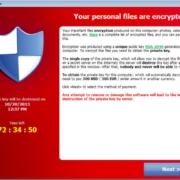Sextortion Scams & Cyber Blackmail on the Rise
Sextortion scams are on the rise, and cyber criminals are using our discomfort in talking about this subject to continue exploiting us. Because the topic is a bit embarrassing for some, communication and awareness of the scam are sorely lacking. This episode of Sileo On Security is meant to put an end to that.
[https://player.vimeo.com/video/300871800′ format=’16-9′ width=’16’ height=’9′ custom_class=” av_uid=’av-jf1kxr’
Sextortion scams, simply put, are a type of blackmail. In a mass-generated email that feels like someone is watching you (they aren’t), the (s)extortionist most often claims to have photos or videos of you, the victim, in embarrassing situations such as watching adult entertainment on your computer. To put you in a panicked state where you react before thinking, the criminal threatens to send the compromising materials to your entire email address book if you don’t pay a ransom within a short time period. Sex + Extortion = Sextortion.
At this point, the scammer can take the sextortion scam in several directions. They can try to get you to make an anonymous, untraceable and completely unrecoverable Bitcoin or cryptocurrency payment into their digital wallet. Or, they might request access to your device to help you clean the RAT off of your machine.
Hang on, what’s does a RAT have to do with sextortion scams?
In a new twist on old Sextortion scams, hackers claim to have downloaded a Remote Access Trojan (RAT) onto your system, allowing them to take complete control of the device. With this “control”, they threaten to send out compromised files (e.g., videos of you watching pornography) directly from your computer, making it look like you have sent the embarrassing materials in person.
To increase the credibility of their claims and your level of panic, they often reveal a password of yours within the email that they have supposedly “hacked in the process”. This is completely freaky and makes you feel grossly uncomfortable, like you’ve done something wrong – which is EXACTLY what they want. While the password they reveal may be a bit old, it’s often a password you once used, which gives credence to their legitimacy, putting you in a mindset to pay their ransom demands or otherwise follow their instructions.
You should know that the password they are using was most likely part of an earlier data breach that you were involved with. The password might have been part of the LinkedIn, Anthem, Equifax, Yahoo or other breach from years past. But the result is the same – you feel like you’ve totally been hacked.
To make matters worse and ratchet up the believability of sextortion scams, the “From:” field in the sextortion email has your name and email address in it, making it look like the hacker has in fact gained access into your email program and sent you an email through your own account. This is a simple technique called spoofing, and reinforces suspicions that your machine has in fact been taken over.
Dealing with Sextortion Scams without Losing Your Pants
Here’s what you need to know. Except in very rare cases, everything about sextortion is a complete hoax, including the fact that they have photos or videos on you, that they’ve successfully placed a RAT on your machine or that they can read and record your every keystroke. This is simply a more effective type of scam known as spear phishing, which just means that they are using previously obtained information (like your breached password) to gain your trust, to target you like a spear targeting a fish, before they use it against you.
If you’ve received the email at work, report it to your IT department and follow your organization’s procedures for scam emails. Everyone else should do the following:
- Be suspicious of all emails, calls, texts or conversations that use fear or embarrassment to get you to act. If you have been in one of my keynote speeches, you’ve already been trained on a B.S. Reflex – a natural tendency to Be Skeptical before you act.
- Never open any attachments or click on any links that you haven’t first verified as legitimate. When in doubt, delete the email and never respond to it.
- Never provide personal information unless you can confirm the legitimate source of the request and safe transmission of the data.
- Turn off and cover your webcam when not in use. I simply place a sticky note over mine and take it off when I am using it.
- Finally, make sure that any passwords revealed in the email aren’t used on ANY of your online accounts. This is an excellent chance to update any weak passwords in password management software like 1Password, Dashlane or Lastpass.
And most importantly, don’t be ashamed. Cyber criminals are mass mailing sextortion schemes to hundreds of millions of people, playing on one of our greatest fears – that of being publicly embarrassed.
Take a minute to educate someone you care about on email extortion and then check back with Sileo On Security for updates on this and other scams. It’s my goal in life to never let the enemy win.
John Sileo is the award winning author of the newly released mini-book Your Data is Showing: 12 Privacy Tools for the Surveillance Economy. His greatest enjoyment comes from energizing keynote audiences to care about cybersecurity, privacy and cutting-edge tools of information weaponization. Watch him on 60-Minutes, Anderson Cooper, Rachael Ray or on stage. Contact him directly on 303.777.3221.






